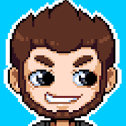I recently started to learn Farseer engine by following Roy Triesscheijn's tutorial. After the tutorial, I attempted a little platformer project (very simple really, just 2 boxes and a single platform) so I can get used to it. I added a control mechanism to the first box (call it box1), so I can move it around the platform and see if it works. It compiles without a problem and when it hits the other box (box2), it 'pushes' box2, which is what I expected.
However, I accidentally (just a twich of the finger) pressed the left arrow key, which moved box1 to the left briefly, and released it again, all while still holding the right arrow key (to explain it further, at the time I was holding right arrow key and was pushing box2 to the right). And to my surprise, while box1 continued to move right, it no longer collided with box2. Instead, it simply goes behind it, and move right. No collision occurred afterwards, even when I tried to hit box2 again, either form the right side, or left side. It simply went through it.
I have 2 classes. One is the default Game1.cs, and the other is DrawablePhysicsObject.cs. Here they are:
DrawablePhysicsObject.cs:
using System;
using System.Collections.Generic;
using System.Linq;
using System.Text;
using Microsoft.Xna.Framework;
using Microsoft.Xna.Framework.Graphics;
using FarseerPhysics.Dynamics;
using FarseerPhysics.Factories;
namespace FarseerTest
{
class DrawablePhysicsObject
{
// First, unit conversion, since Farseer uses meters
public const float UNIT_TO_PIXEL = 100f;
public const float PIXEL_TO_UNIT = 1 / UNIT_TO_PIXEL;
public Body body;
public Texture2D texture;
private Vector2 _size;
/// <summary>
/// The position of the body
/// </summary>
public Vector2 Position
{
get { return body.Position * UNIT_TO_PIXEL; }
set { body.Position = value * PIXEL_TO_UNIT; }
}
/// <summary>
/// Getter and setter for _size
/// </summary>
public Vector2 Size
{
get { return _size * UNIT_TO_PIXEL; }
set { _size = value * PIXEL_TO_UNIT; }
}
/// <summary>
/// Creates a new DrawablePhysicsObject
/// </summary>
/// <param name="world"></param>
/// <param name="texture"></param>
/// <param name="size"></param>
/// <param name="mass"></param>
public DrawablePhysicsObject(World world, Texture2D texture, Vector2 size, float mass)
{
body = BodyFactory.CreateRectangle(world, size.X * PIXEL_TO_UNIT, size.Y * PIXEL_TO_UNIT, mass);
body.BodyType = BodyType.Dynamic;
this.Size = size;
this.texture = texture;
}
public void Draw(SpriteBatch spriteBatch)
{
Vector2 scale = new Vector2(Size.X / (float)texture.Width, Size.Y / (float)texture.Height);
spriteBatch.Draw(texture, Position, null, Color.White, body.Rotation, new Vector2(texture.Width / 2f, texture.Height / 2f), scale, SpriteEffects.None, 0);
}
}
}
Game1.cs:
using System;
using System.Collections.Generic;
using System.Linq;
using Microsoft.Xna.Framework;
using Microsoft.Xna.Framework.Audio;
using Microsoft.Xna.Framework.Content;
using Microsoft.Xna.Framework.GamerServices;
using Microsoft.Xna.Framework.Graphics;
using Microsoft.Xna.Framework.Input;
using Microsoft.Xna.Framework.Media;
using FarseerPhysics.Dynamics;
using FarseerPhysics.Factories;
namespace FarseerTest
{
/// <summary>
/// This is the main type for your game
/// </summary>
public class Game1 : Microsoft.Xna.Framework.Game
{
GraphicsDeviceManager graphics;
SpriteBatch spriteBatch;
World world;
List<DrawablePhysicsObject> boxList;
DrawablePhysicsObject floor;
DrawablePhysicsObject box1;
DrawablePhysicsObject box2;
Vector2 boxSize;
Texture2D boxTexture;
Vector2 speed;
KeyboardState prevKeyboardState;
public Game1()
{
graphics = new GraphicsDeviceManager(this);
Content.RootDirectory = "Content";
}
/// <summary>
/// Allows the game to perform any initialization it needs to before starting to run.
/// This is where it can query for any required services and load any non-graphic
/// related content. Calling base.Initialize will enumerate through any components
/// and initialize them as well.
/// </summary>
protected override void Initialize()
{
boxSize.X = 10f;
boxSize.Y = 10f;
boxTexture = Content.Load<Texture2D>(@"Images/Crate");
speed.X = 1f;
speed.Y = 0;
base.Initialize();
}
/// <summary>
/// LoadContent will be called once per game and is the place to load
/// all of your content.
/// </summary>
protected override void LoadContent()
{
// Create a new SpriteBatch, which can be used to draw textures.
spriteBatch = new SpriteBatch(GraphicsDevice);
world = new World(new Vector2(0, 9.8f));
floor = new DrawablePhysicsObject(world, Content.Load<Texture2D>(@"Images/Floor"),
new Vector2(GraphicsDevice.Viewport.Width, 100f), 1000);
floor.Position = new Vector2(GraphicsDevice.Viewport.Width / 2f, // Set it to half the screen width
GraphicsDevice.Viewport.Height - 50); // And 50 pixels from the bottom
floor.body.BodyType = BodyType.Static;
box1 = new DrawablePhysicsObject(world, boxTexture, boxSize, 1f);
box2 = new DrawablePhysicsObject(world, boxTexture, boxSize, 1f);
box1.Position = new Vector2(0, 50);
box2.Position = new Vector2(200, 50);
}
/// <summary>
/// UnloadContent will be called once per game and is the place to unload
/// all content.
/// </summary>
protected override void UnloadContent()
{
// TODO: Unload any non ContentManager content here
}
/// <summary>
/// Allows the game to run logic such as updating the world,
/// checking for collisions, gathering input, and playing audio.
/// </summary>
/// <param name="gameTime">Provides a snapshot of timing values.</param>
protected override void Update(GameTime gameTime)
{
// Allows the game to exit
if (GamePad.GetState(PlayerIndex.One).Buttons.Back == ButtonState.Pressed)
this.Exit();
world.Step((float)gameTime.ElapsedGameTime.TotalSeconds);
if (Keyboard.GetState().IsKeyDown(Keys.Right))
{
box1.Position += speed;
}
if (Keyboard.GetState().IsKeyDown(Keys.Left))
{
box1.Position -= speed;
}
base.Update(gameTime);
}
/// <summary>
/// This is called when the game should draw itself.
/// </summary>
/// <param name="gameTime">Provides a snapshot of timing values.</param>
protected override void Draw(GameTime gameTime)
{
GraphicsDevice.Clear(Color.CornflowerBlue);
spriteBatch.Begin(SpriteSortMode.Immediate, BlendState.Opaque);
box1.Draw(spriteBatch);
box2.Draw(spriteBatch);
floor.Draw(spriteBatch);
spriteBatch.End();
base.Draw(gameTime);
}
}
}
And I've attached a demo so you can see the situation for yourself. To reproduce the problem, keep holding right arrow key and, while pushing box2, hit left arrow, but don't release right arrow key.
Thank you for your answers.





